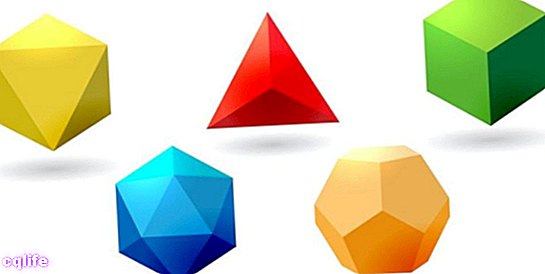We explain what polyhedra are in geometry, their elements, classification and examples. Also, how are they called.

What are polyhedra?
According to classical geometry, certain three-dimensional geometric bodies are called polyhedrons, with flat faces and enclosing a volume finite. In other words, a polyhedron is a bounded portion of space geometric, bounded by different polygons. Its name comes from the Greek voice polyedron, composed by polys: "Many", and edra: "Base" or "face".
Its denomination depends on the number of faces it presents, using for this prefixes numerals of Greek descent and the ending -aedron. For example: tetrahedra (4 faces), pentahedra (5 faces), hexahedra (6 faces) and so on. Also, many polyhedra have their proper names, such as cube, prism, pyramid, etc.
Elements of polyhedra
All polyhedra have the same elements, although in different quantity and shape.Polyhedra are made up of the following elements:
- Faces The flat surfaces that delimit the internal space of the polyhedron. They are two-dimensional and are closed figures made up of lines. It can also be said that they are the polygons that constitute it. Among them, the bases are usually distinguished, which are simply the faces on which the polyhedron rests.
- Edges. The lines that make up the body of a polyhedron, and at whose intersections the vertices appear.
- Vertices. The angles of meeting between three or more edges in the body of a polyhedron.
Classification of polyhedra
Beyond naming them according to their number of faces, as we explained at the beginning, polyhedra can be classified according to the shape and relationship of their faces, thus having:
- Regular polyhedra. When all of its faces are regular polygons.
- Uniform polyhedra. When all their faces are equal to each other.
- Irregular polyhedra. When they have faces that are unequal to each other.
Examples of polyhedra
A dodecahedron has twelve regular and uniform faces.The following are examples of polyhedra:
- Pyramids Made up of a base and various triangular faces.
- Cubes Formed by the union of six regular rectangles.
- Parallelepipeds. Constructed by two regular squares and four rectangles equal to each other.
- Prisms Whose faces are parallelograms, as many according to sides have their two bases.
- Dodecahedra. Concave or convex polyhedra with twelve regular and uniform faces.
- Octahedron. Built by joining two pyramids at the base.
